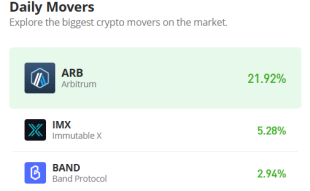Join Our Telegram channel to stay up to date on breaking news coverage
Ethereum’s latest Shanghai update has caused some inconvenience for cryptocurrency investors eager to withdraw their funds. This has brought attention to the limitations of Ethereum’s transaction processing capabilities.
Ethereum’s Upgrade: $30 Billion Locked Up, Potential Limitations Revealed
The upgrade was anticipated to unlock a massive amount of ether, over $30 billion in fact, but due to the staking process, investors had to wait for the upgrade to complete before withdrawing their funds. There is a backlog of around $1.4 billion worth of ether stuck in a withdrawal queue currently, shedding light on the potential limitations of Ethereum as a widely-used financial infrastructure.
The excessive load on the network has been due to an overwhelming amount of transactions, more than the network could handle. These limitations were placed as a security measure, to prevent any illicit activities on the network.
Martin Lee, an analyst, noted that removing these limits could leave the Ethereum network vulnerable to attacks. The ongoing delays highlight the challenges that Ethereum has faced in gaining widespread adoption in traditional payments, finance, and commerce, despite its popularity in niche areas like decentralized finance and NFTs.
Binance, the biggest cryptocurrency exchange, has informed users that they can withdraw their ether from its staking product from April 19. However, processing these transactions may take “15 days to several weeks” due to the processing limitations on the Ethereum network.
Binance will set a daily ETH redemption quota for each user to help manage the backlog. Nansen’s Lee predicts that the backlog will take weeks to clear, and then it will depend on the average daily “unstaking” amount before investors can expect quick withdrawals.
This withdrawal incident experienced by investors on the Ethereum blockchain as a result of the Shapella upgrade was critical in determining the network’s current limitations.
Despite its popularity in certain areas of the crypto market, the delays have highlighted potential shortcomings in its ability to become a widely-used financial infrastructure. To be considered a viable option for mainstream payments, finance, or commerce, these ongoing delays will need to be resolved.
How Has The Update Affected Ethereum?
Ethereum recently underwent a major upgrade called the “Shanghai Update”. This update aims to improve the network’s efficiency and security while also enabling those who have previously staked their ether (ETH) on the network to withdraw their earnings for the first time.
The move is part of the network’s transition from a proof-of-work (PoW) consensus mechanism to a proof-of-stake (PoS) one. Ethereum has been using PoS since December 2020, but this will be the first time that stakers can withdraw their earnings.
Despite the fact that there are limitations on the number of withdrawals that can be made per block, there is still concern among investors that allowing the withdrawal of staked ETH may cause a temporary drop in the coin’s value.
This apprehension stems from the possibility that numerous users who were previously unable to sell their staked ETH might sell their holdings all at once, leading to a $2.4 billion selling pressure on the market. It is worth noting, however, that not all staked ETH can be withdrawn simultaneously.
The Shanghai Upgrade is also introducing several technical improvements to Ethereum transactions, such as EIP-3651, EIP-3855, and EIP-3860, which aim to improve the network’s efficiency and lower gas fees for decentralized applications.
The upgrade is a hard fork, meaning the non-upgraded nodes will no longer participate in the staking and validation process.
The upgrade will also apply changes to the Consensus Layer, leading to the joint moniker “Shapella” for the combination of these two upgrades. The aim of the upgrade is to improve liquidity for stakers and validators who wish to withdraw their funds.
Ethereum staking refers to the process of validating a transaction on the Ethereum blockchain network. By improving liquidity, the Shanghai Update could help drive utilization in the network up over time.
The upgrade comes at a time when there is an ongoing debate about the environmental impact of cryptocurrencies. PoW requires miners to use computer hardware to prove their reliability to the network, while PoS involves the staking of a crypto asset. PoS proponents often view PoW as wasteful, while proponents of PoW view it as less secure and prone to centralization.
The implementation of the Shanghai Update marks a major achievement in Ethereum’s shift towards a PoS consensus mechanism. Despite apprehensions about the coin’s short-term price fluctuations, the token has moved past the $2,100 mark. The update has the capability to enhance network effectiveness and liquidity, which may ultimately prove advantageous for the Ethereum ecosystem.
Staking Deposits Surge on Ethereum Network After Shanghai Upgrade Allows Withdrawals
There has been a surge in staking deposits on the Ethereum network following the latest Shanghai upgrade. Token holders who’ve staked their ETH for two years now finally have the chance to withdraw their holdings. Staking has now become incredibly critical for the Ethereum network.
Although ETH deposits are still in the negative, with more users withdrawing than staking assets, market analysts aren’t concerned. They believe that validators who have accrued excess ETH from earnings would want to unstake since they are only accruing rewards on 32 ETH.
Validators can choose between a partial exit or a full exit when leaving the network, with a partial exit referring to validators simply withdrawing their accrued rewards while keeping their 32 ETH stake on the network. In contrast, a full exit means that validators withdraw their rewards, initial 32 ETH deposit, and leave the network entirely.
It is worth noting that at one point, deposits on the Ethereum network exceeded withdrawals by a significant margin. There were 27,000 ETH deposited, while only 7,615 ETH was withdrawn. Several companies were among the top competitors for these deposits, such as Lido, OKX, Kiln.fi, and Frax, as well as an unidentified wallet known as “P2p ETH2 Depositor,” which deposited a massive amount of 50,000 ETH.
This surge in withdrawals is expected, and the network will soon hit a “baseline” once the first wave of validators claims their accumulated rewards. At present, over 874,000 ETH is still waiting to exit the network, but it is likely that some of this ETH will get put right back to work based on current trends.
Read More
Join Our Telegram channel to stay up to date on breaking news coverage


